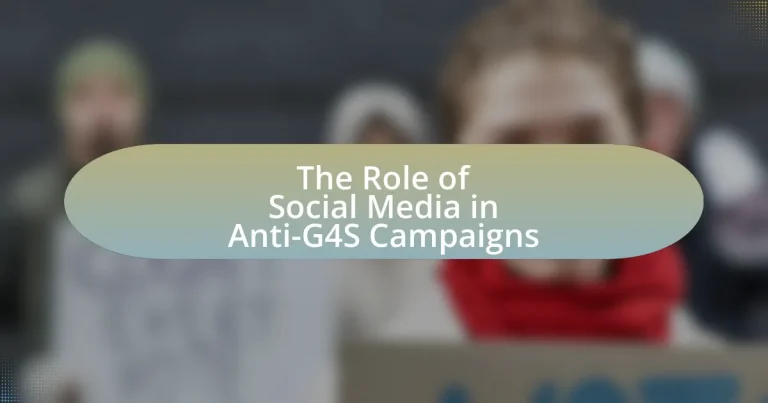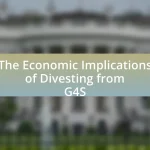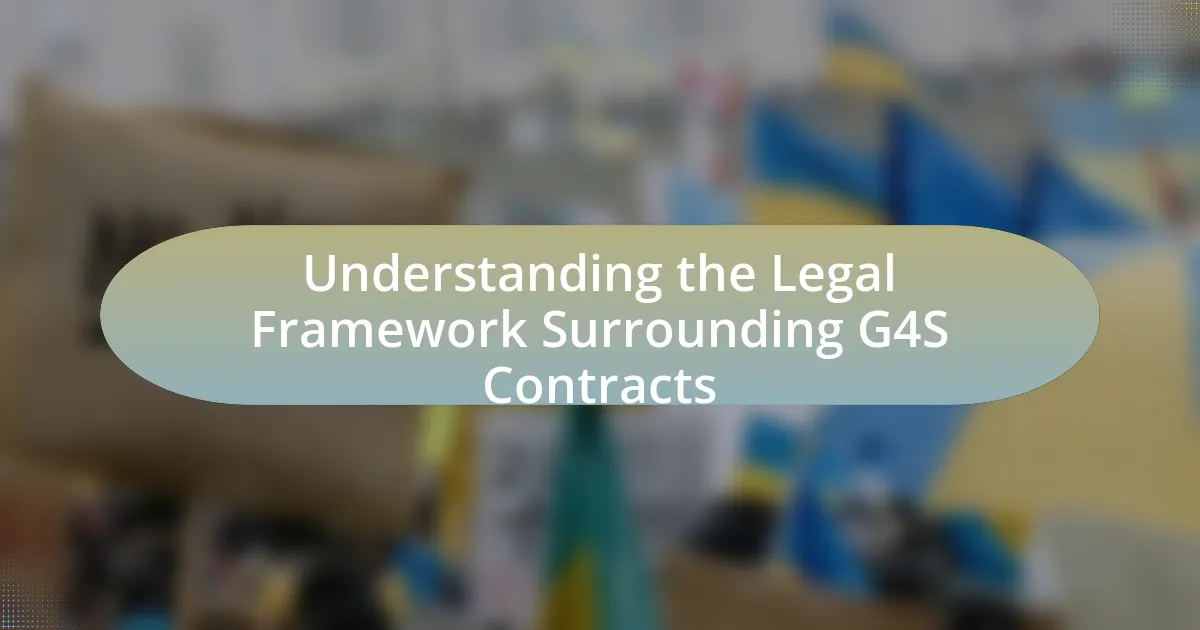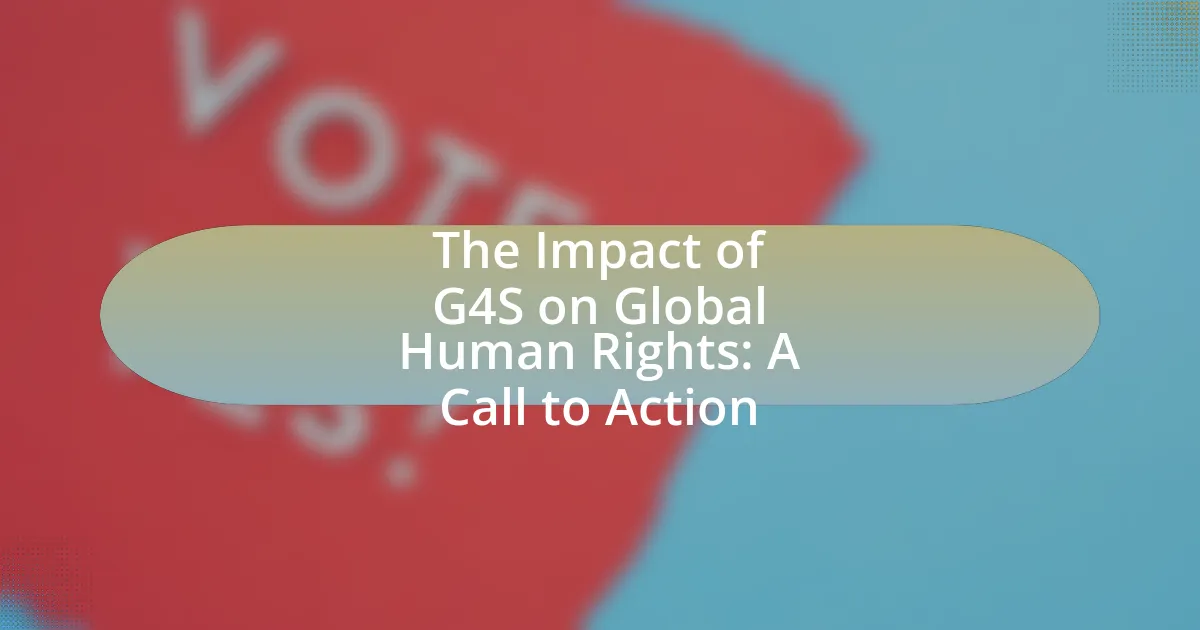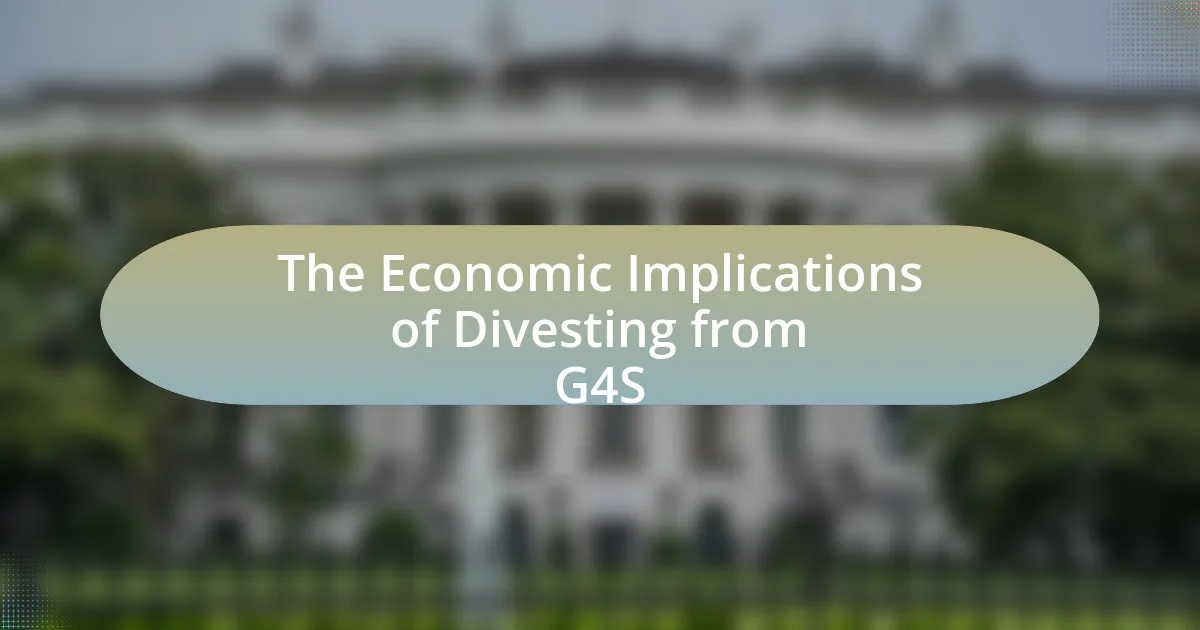The article examines the significant role of social media in anti-G4S campaigns, highlighting how platforms like Twitter and Facebook facilitate the rapid dissemination of information and mobilization of public opinion against the company. It discusses the influence of social media on public perception, the effectiveness of specific platforms, and the strategies employed in campaigns, such as hashtag activism and targeted messaging. Additionally, the article addresses the challenges faced by these campaigns, including misinformation and audience fragmentation, while emphasizing the importance of community engagement and compelling content in driving awareness and action against G4S’s controversial practices.
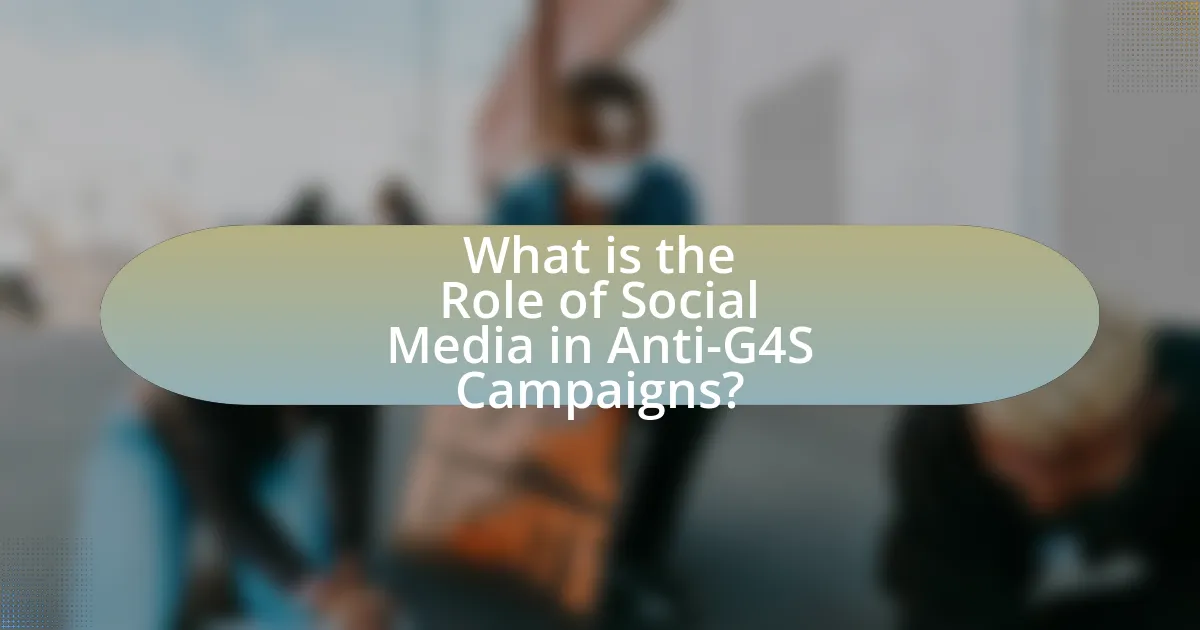
What is the Role of Social Media in Anti-G4S Campaigns?
Social media plays a crucial role in anti-G4S campaigns by facilitating the rapid dissemination of information and mobilizing public opinion against the company. Platforms like Twitter, Facebook, and Instagram enable activists to share real-time updates, organize protests, and raise awareness about G4S’s controversial practices, such as its involvement in detention centers and security operations in conflict zones. For instance, campaigns like “Boycott G4S” have gained traction through viral posts and hashtags, leading to increased public scrutiny and pressure on institutions to sever ties with the company. This digital activism has been effective in amplifying voices that challenge G4S’s operations, demonstrating the significant impact social media has in shaping narratives and influencing corporate accountability.
How has social media influenced public perception of G4S?
Social media has significantly influenced public perception of G4S by amplifying negative narratives and increasing awareness of the company’s controversies. Platforms like Twitter and Facebook have facilitated the rapid dissemination of information regarding G4S’s involvement in various scandals, such as allegations of human rights abuses and mismanagement in security operations. For instance, the widespread sharing of videos and articles detailing incidents involving G4S personnel has led to public outrage and calls for accountability. This heightened visibility has contributed to a decline in G4S’s reputation, as social media users often mobilize to support campaigns against the company, further shaping negative public sentiment.
What specific social media platforms are most effective in anti-G4S campaigns?
Twitter and Facebook are the most effective social media platforms in anti-G4S campaigns. Twitter’s real-time engagement allows activists to quickly mobilize support and share information, while Facebook’s extensive user base facilitates community building and event organization. Research indicates that campaigns utilizing these platforms can reach a wider audience and generate significant public discourse, as evidenced by the #G4S campaign that gained traction on both platforms, leading to increased awareness and action against the company.
How do social media narratives shape the discourse around G4S?
Social media narratives significantly shape the discourse around G4S by amplifying public perceptions and mobilizing collective action against the company. These platforms facilitate the rapid dissemination of information, allowing users to share personal experiences and critiques related to G4S’s operations, such as allegations of human rights abuses and privatization of public services. For instance, campaigns like #BoycottG4S have gained traction on Twitter and Facebook, leading to increased visibility of G4S’s controversial practices and influencing public opinion. Research indicates that social media can alter consumer behavior, with 70% of users reporting that online discussions impact their views on brands. This dynamic creates a feedback loop where heightened scrutiny from social media users pressures G4S to respond to criticisms, thereby shaping the overall narrative surrounding the company.
Why are anti-G4S campaigns significant in the context of social justice?
Anti-G4S campaigns are significant in the context of social justice because they highlight and challenge the role of private security firms in perpetuating systemic inequalities and human rights abuses. These campaigns often focus on G4S’s involvement in controversial practices, such as operating in conflict zones and providing security for institutions linked to oppression, which raises ethical concerns about accountability and complicity in state violence. For instance, G4S has faced criticism for its operations in Israel and Palestine, where its security services have been associated with the enforcement of occupation policies. This scrutiny fosters public awareness and mobilizes collective action, making it a crucial element in the broader struggle for social justice.
What role does social media play in mobilizing grassroots movements against G4S?
Social media serves as a crucial tool for mobilizing grassroots movements against G4S by facilitating rapid communication, organization, and awareness. Platforms like Twitter and Facebook enable activists to share information about G4S’s controversial practices, such as its involvement in immigration detention and security services, reaching a wide audience quickly. For instance, campaigns like “Boycott G4S” have gained traction through viral posts and hashtags, allowing supporters to coordinate protests and share resources effectively. This digital engagement has led to increased visibility and public discourse around G4S’s actions, ultimately pressuring institutions to reconsider their contracts with the company.
How do social media campaigns contribute to raising awareness about G4S’s practices?
Social media campaigns significantly raise awareness about G4S’s practices by disseminating information rapidly and engaging a wide audience. These campaigns utilize platforms like Twitter, Facebook, and Instagram to share content that highlights issues such as human rights violations and unethical business practices associated with G4S. For instance, organizations like Amnesty International have leveraged social media to circulate reports and personal testimonies, which have garnered thousands of shares and comments, amplifying the message. This widespread engagement not only informs the public but also pressures stakeholders and policymakers to address the concerns raised, demonstrating the effectiveness of social media as a tool for advocacy and awareness.
What strategies are employed in social media campaigns against G4S?
Social media campaigns against G4S employ strategies such as targeted messaging, hashtag activism, and mobilization of grassroots movements. Targeted messaging focuses on highlighting specific issues related to G4S, such as human rights violations and unethical practices, to raise awareness among the public. Hashtag activism, exemplified by campaigns like #BoycottG4S, facilitates the spread of information and encourages collective action. Grassroots mobilization involves organizing protests and events that leverage social media for coordination and outreach, effectively amplifying the campaign’s reach and impact. These strategies are validated by the increased visibility and public discourse surrounding G4S’s controversial practices, as evidenced by numerous reports and studies documenting the company’s involvement in various human rights issues.
How do hashtags and viral content enhance the visibility of anti-G4S messages?
Hashtags and viral content significantly enhance the visibility of anti-G4S messages by facilitating broader reach and engagement across social media platforms. Hashtags categorize content, making it easily discoverable by users interested in specific topics, thereby amplifying the audience for anti-G4S sentiments. For instance, campaigns utilizing hashtags like #BoycottG4S have garnered thousands of posts, creating a collective voice that attracts media attention and public discourse. Viral content, characterized by its shareability and emotional resonance, further propels these messages into mainstream conversations, as seen in instances where videos or infographics highlighting G4S’s controversial practices rapidly circulate online. This combination of strategic hashtag use and engaging content not only raises awareness but also mobilizes support for anti-G4S initiatives, evidenced by increased participation in protests and online discussions.
What role do influencers and activists play in these campaigns?
Influencers and activists play a crucial role in anti-G4S campaigns by amplifying messages, mobilizing support, and raising awareness about human rights issues associated with the company. Their extensive reach on social media platforms allows them to engage a broader audience, effectively disseminating information and fostering community action. For instance, campaigns led by activists often utilize hashtags and viral content to draw attention to specific incidents of misconduct, thereby increasing public scrutiny of G4S’s operations. Research indicates that social media activism can significantly influence public perception and policy discussions, demonstrating the power of these individuals in shaping narratives and driving change.
How do social media campaigns measure their impact on anti-G4S efforts?
Social media campaigns measure their impact on anti-G4S efforts primarily through engagement metrics, sentiment analysis, and reach statistics. Engagement metrics, such as likes, shares, and comments, provide quantitative data on how audiences interact with content related to anti-G4S initiatives. Sentiment analysis tools assess the emotional tone of discussions surrounding G4S, indicating public perception and support levels. Additionally, reach statistics, including impressions and follower growth, help gauge the campaign’s visibility and influence. For instance, a campaign that generates a significant increase in shares and positive sentiment can be considered effective in raising awareness and mobilizing support against G4S.
What metrics are used to evaluate the success of these campaigns?
The metrics used to evaluate the success of anti-G4S campaigns on social media include engagement rates, reach, conversion rates, and sentiment analysis. Engagement rates measure interactions such as likes, shares, and comments, indicating how well the content resonates with the audience. Reach assesses the total number of unique users who see the campaign content, reflecting its visibility. Conversion rates track the percentage of users who take a desired action, such as signing a petition or donating, demonstrating the campaign’s effectiveness in mobilizing support. Sentiment analysis evaluates the overall tone of the conversations surrounding the campaign, providing insights into public perception and emotional response. These metrics collectively offer a comprehensive view of the campaign’s impact and effectiveness in raising awareness and driving action against G4S.
How can engagement levels on social media correlate with real-world actions against G4S?
Engagement levels on social media can significantly correlate with real-world actions against G4S by amplifying awareness, mobilizing supporters, and facilitating organization. High engagement, such as shares, comments, and likes, often indicates a growing public interest and concern regarding G4S’s practices, which can lead to increased participation in protests, petitions, or boycotts. For instance, the #BoycottG4S campaign gained traction on platforms like Twitter and Facebook, resulting in organized demonstrations and public statements from various advocacy groups. This correlation is supported by studies showing that social media campaigns can lead to tangible outcomes, such as the 2018 protests against G4S in the UK, where online mobilization translated into significant offline actions, demonstrating the direct impact of social media engagement on real-world activism.
What challenges do social media campaigns face in anti-G4S activism?
Social media campaigns in anti-G4S activism face significant challenges, including misinformation, algorithmic bias, and audience fragmentation. Misinformation can undermine campaign credibility, as false narratives about G4S can spread rapidly, confusing potential supporters. Algorithmic bias on platforms like Facebook and Twitter can limit the visibility of anti-G4S content, as these algorithms often prioritize engagement over informative content, potentially sidelining critical messages. Additionally, audience fragmentation occurs when activists struggle to reach diverse groups due to varying platform preferences, making it difficult to unify efforts and mobilize a broad base of support. These challenges hinder the effectiveness of social media as a tool for activism against G4S.
How do misinformation and counter-narratives affect anti-G4S campaigns?
Misinformation and counter-narratives significantly undermine anti-G4S campaigns by distorting public perception and creating confusion. Misinformation can spread false claims about G4S’s operations, leading to misinformed public outrage or support, while counter-narratives can dilute the impact of legitimate criticisms by framing them as biased or exaggerated. For instance, social media platforms facilitate rapid dissemination of both misinformation and counter-narratives, making it challenging for activists to maintain a coherent message. Research indicates that misinformation can lead to a 70% increase in public skepticism towards anti-G4S messages, as seen in various campaigns where misleading information overshadowed factual reporting.
What are the risks of online activism in the context of anti-G4S efforts?
The risks of online activism in the context of anti-G4S efforts include potential backlash from law enforcement, surveillance of activists, and the spread of misinformation. Activists may face legal repercussions as G4S has been known to monitor online activities and report individuals to authorities, leading to arrests or harassment. Additionally, the anonymity of online platforms can facilitate the dissemination of false information, which can undermine the credibility of the movement and create divisions among supporters. Furthermore, online activism can lead to digital harassment or doxxing, where personal information of activists is exposed, putting their safety at risk. These factors highlight the complex landscape of online activism against G4S, where the benefits of raising awareness must be weighed against significant personal and organizational risks.
What best practices can enhance the effectiveness of social media in anti-G4S campaigns?
To enhance the effectiveness of social media in anti-G4S campaigns, organizations should focus on creating engaging, informative content that resonates with their target audience. Utilizing storytelling techniques can humanize the issues related to G4S, making the campaign more relatable and impactful. Additionally, leveraging data analytics to identify peak engagement times and preferred platforms can optimize outreach efforts.
Incorporating visuals, such as infographics and videos, can significantly increase shareability and engagement rates, as studies show that posts with images receive 94% more views than those without. Collaborating with influencers who align with the campaign’s values can also amplify reach and credibility. Furthermore, maintaining consistent messaging across all platforms ensures clarity and reinforces the campaign’s objectives.
Finally, actively engaging with followers through comments and direct messages fosters a sense of community and encourages further participation in the campaign.
How can activists create compelling content that resonates with audiences?
Activists can create compelling content that resonates with audiences by utilizing storytelling techniques, emotional appeals, and data-driven insights. Storytelling engages audiences by presenting relatable narratives that highlight personal experiences or injustices, making the cause more tangible. Emotional appeals, such as evoking empathy or urgency, can motivate individuals to take action or share the content. Data-driven insights, including statistics and research findings, provide credibility and reinforce the message, demonstrating the significance of the issue. For instance, a campaign might share a personal story of an individual affected by G4S practices, supported by statistics on human rights violations, to create a powerful narrative that encourages audience engagement and sharing.
What strategies can be employed to foster community engagement and support?
To foster community engagement and support, organizations can utilize targeted social media campaigns that encourage participation and dialogue. These campaigns can include interactive content such as polls, live Q&A sessions, and community challenges that invite members to share their experiences and opinions. Research indicates that social media platforms can enhance community involvement by providing a space for real-time communication and feedback, which strengthens relationships and builds trust among community members. For instance, a study by the Pew Research Center found that 69% of adults in the U.S. use social media, highlighting its potential as a tool for outreach and engagement.
